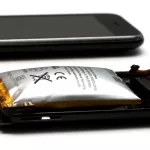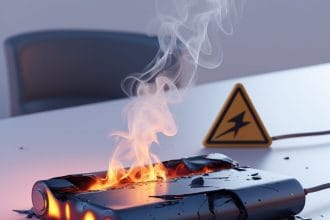We carry powerful energy sources in our pockets every day—lithium-ion batteries that power our smartphones, laptops, and other electronics. While these batteries are generally safe when handled properly, they can pose significant explosion risks under certain conditions. This article explains why lithium-ion batteries have explosion risks, how to minimize them, and best practices for safe use and repair.
How Dangerous Are Lithium-Ion Batteries?
Lithium-ion batteries store energy through chemical reactions inside sealed cells. When a battery is fully charged and damaged, it can trigger dangerous reactions, increasing the explosion risks. If the internal components are pierced or short-circuited, intense heat can build up rapidly, potentially causing a fire or explosion.
The Risks of Battery Damage
When repairing electronics, it’s critical to avoid damaging the battery. Piercing or puncturing a battery creates a short circuit between its positive and negative layers, which dramatically raises explosion risks. This causes a sudden surge of current, producing heat that can ignite the flammable electrolyte inside. This chain reaction is known as thermal runaway, a key factor in battery explosion risks.
Why Charge Level Matters
The battery’s charge level plays a major role in the explosion risks. A battery with low or partial charge contains less stored energy and is less likely to cause a fire if damaged. In contrast, a fully charged battery has a much higher risk of igniting if punctured or crushed. Therefore, discharging the battery below 25% before repair is essential to reduce explosion risks.
Size Matters Too
Larger batteries, like those in laptops or electric vehicles, hold significantly more energy than smartphone batteries. Damage to these larger cells can lead to more intense fires that spread quickly and are harder to control. This is why glued-in batteries can be especially problematic during repairs.
Safe Practices for Repair and Use
- Always discharge batteries below 25% charge before starting any repairs.
- Avoid using or charging swollen or damaged batteries—replace them immediately.
- Use only manufacturer-approved chargers and cables.
- Keep devices away from extreme heat sources.
- Never carry damaged or swollen batteries in your pockets.
What Is Thermal Runaway?
Thermal runaway is a dangerous, self-sustaining reaction inside a battery. When the separator between positive and negative layers is compromised, a short circuit occurs, generating intense heat. This heat vaporizes the electrolyte, which ignites upon contact with air, causing a fire that spreads rapidly within the battery.
Looking Ahead: Safer Battery Technologies
Emerging technologies like solid-state batteries aim to reduce these risks by replacing flammable liquid electrolytes with safer solid materials. These advancements promise higher performance with much-improved safety profiles in the near future.
Conclusion
Lithium-ion batteries are essential to modern life but require careful handling. Properly discharging batteries before repair, avoiding damaged cells, and following safety guidelines can significantly reduce explosion risks. With awareness and precautions, you can keep your devices—and yourself—safe.















test